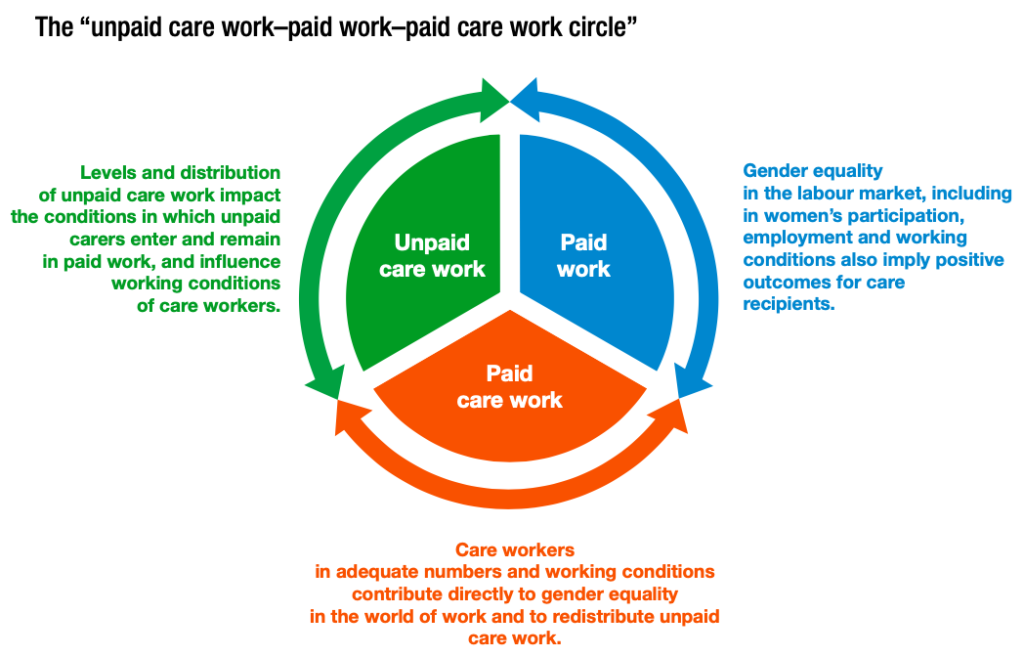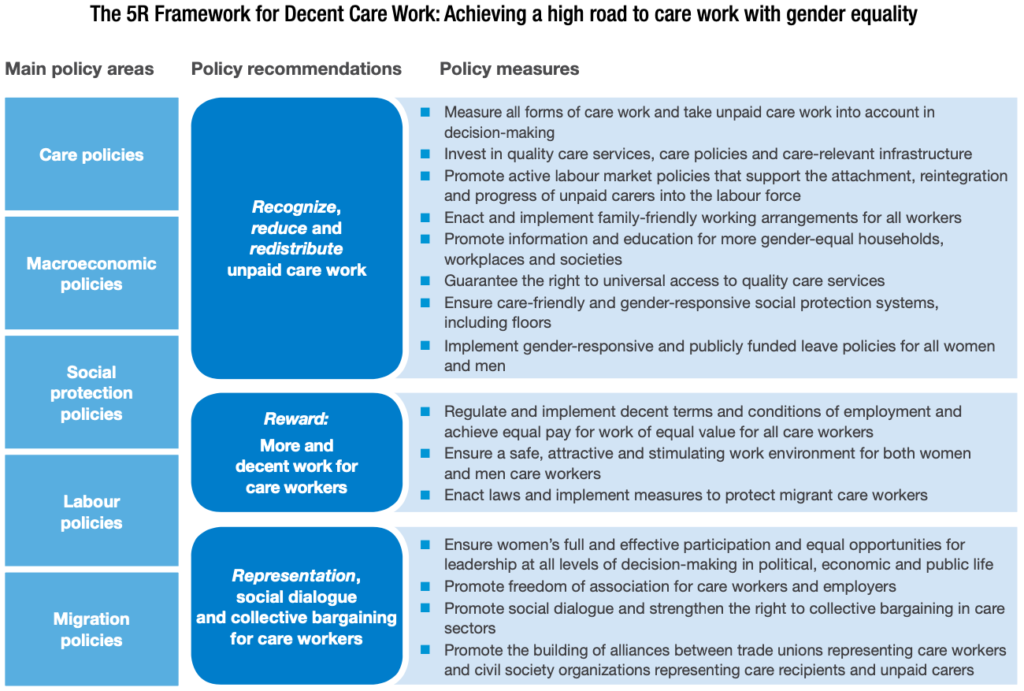ForumIAS announcing GS Foundation Program for UPSC CSE 2025-26 from 19 April. Click Here for more information.
Contents
- 1 Introduction
- 2 What is Care Work?
- 3 What is the significance of Care Work?
- 4 What are the reasons for rising demand for Care Work?
- 5 What is the need for India to focus on Care Work and Care Economy?
- 6 What steps have been taken by the Government towards the Care Economy?
- 7 What are the issues surrounding Care Work in India?
- 8 What steps should be taken to support the Care Economy?
- 9 Conclusion
| For 7PM Editorial Archives click HERE → |
Introduction
The importance of care work is now widely acknowledged and reflected in various international commitments such as the SDGs and the International Labour Organization (ILO)’s Centenary Declaration. The Care Economy became the target of policy discussions after the ILO released a study titled ‘Care Work and Care Jobs for the Future of Decent Work‘ in 2018. The demand for care services has soared since March 2020. However, investment in the care economy has lagged behind. This year also the ILO released a fresh report titled ‘Care at Work: Investing in Care Leave and Services for a More Gender-Equal World of Work‘ which has called for focused policy support for the care work and care economy.
What is Care Work?
The ILO describes care work commonly as ‘the activities and relationships involved in achieving the physical, mental, and emotional needs of kids and adults, old and young, physically weak and able-bodied‘.
Care workers in care occupations deliver health, social and education services with the support of other workers. Care staff vary from university lecturers, medical practitioners, and dentists on one end of the spectrum to child rearing and personal care staff on another. Domestic staff are also considered care workers.
Care work includes both immediate care tasks like feeding a baby or nursing a sick partner and indirect care operations like cleaning and preparing meals.
What is the significance of Care Work?
First, care work, both paid and unpaid, is extremely important for any social system as well as the economy to survive.
Second, the indispensable aspect of care work was highlighted in the pandemic, when it became challenging to move ahead without the facilities of care staff.
Third, according to the ILO, doubling investment from 2015 levels would result in 117 million additional jobs opportunities by 2030. Further, because of the relational nature of care, such professions are less probable to automation.
Fourth, countries which invest in a combination of childcare infrastructure and parental leave policies to offset the burden on women, have a higher maternal employment to population ratio as per the ILO.
What are the reasons for rising demand for Care Work?
First, in middle- and lower-income nations, demographic shifts are resulting in an increased proportion of the elderly needing extensive care.
Second, rapid urbanization is transforming traditional joint-family structures into nuclear, single-parent, and transnational houses, isolating them from community support bonds.
Third, a rise in female employment owing to better education has reduced women’s unpaid care work burden. This has increased demand for paid care services in cities and urban areas.
What is the need for India to focus on Care Work and Care Economy?
First, the care economy is a major employer with significant growth potential. It employs a sizable percentage of India’s population, particularly women. Further, as the country ages, the demand for care work, particularly personal, household, and health care work, will rise substantially.
The ILO report states that, since global demand for care work is expected to increase by 2030, investment in India’s care economy could generate 11 million employment (of which 32.5 percent will be of women).
Second, since many care staff move to other nations for employment, paid care work has always been a significant source of capital inflows for India. An emphasis on the care economy sphere could help restore and potentially boost India’s foreign remittances.
Third, women and girls account for the majority of paid care staff worldwide and perform the majority of unpaid care work. An attention on the care economy is likely to improve India’s extremely limited female workforce participation rate and ensure gender-inclusive economic growth.
Currently, women’s unpaid work is valued at 3.1% of GDP in India. Recognising AWWs, ANMs, ASHAs and domestic help (amongst others), as formal sector workers would allow their economic contribution to be counted in the GDP.
Fourth, it will also help in achievement of Sustainable Development Goal (SDG) 8. It aims to ‘promote sustained, inclusive and sustainable economic growth, full and productive employment and decent work for all’.
What steps have been taken by the Government towards the Care Economy?
Maternity Act, 2017: It offers 26 weeks of maternity leave, against the ILO’s standard mandate of 14 weeks that exists in 120 countries. It also mandates that employers must provide crèche facilities within a prescribed distance.
The Sexual Harassment of Women at Workplace (Prevention, Prohibition and Redressal) Act and the minimum wage legislations have been made applicable to domestic workers in India.
What are the issues surrounding Care Work in India?
First, unpaid care work is associated with labour market disparities, but it has received insufficient focus in policy making. Due to absence of a proper definition, population studies are helpless to include a section for care staff, both paid and unpaid, leaving no way to reach them and adopt policies directed at their advancement.
Moreover, the undervaluation of unpaid care work also leads to lower wages and a deterioration of working conditions in care sectors, in which women are largely over-represented. Care workers themselves have care needs that often go unmet, due to their low wages and long working hours.
Source: ILO, Care Work and Care Jobs: For the Future of Decent Work
Second, paid caregivers, such as domestic helpers and anganwadi workers in India, also find it difficult to access worker rights and liberties e.g., India’s 2.5 million women Anganwadi Qorkers (AWWs), Auxiliary Nurse-Midwives (ANMs) and Accredited Social-Health Activists (ASHAs) are not recognised as workers or paid fixed monthly salaries in many States.
Third, Government spending on India’s care economy has been exceptionally low when compared to other nations. India spends less than 1% of GDP on care work infrastructure and services, including pre-primary education, maternity, disability and sickness benefits, and long-term care as per the ILO. In contrast, the US administration has allocated US$ 425 billion to the Care Economy sector under the US$ 2.3 trillion American Jobs Plan.
Fourth, COVID-19 induced reverse migration of care workers back to India. This reduced flow of foreign remittances as well as created a significant burden on the Government to accommodate them.
Fifth, there have been implementation issues in government initiatives. For instance, only 49% of employers had creche facilities in place. The absence of clear implementation guidelines, penalty provisions, or monitoring makes non-compliance even more pervasive.
Sixth, while paternity leave is recognised as an enabler for both mothers and fathers to better balance work and family responsibilities; it is not provided in many countries, including India.
What steps should be taken to support the Care Economy?
First, it is imperative to create an identification mechanism for care workers thereby creating a pipeline that could be used to reach them.
Second, once a formal definition is devised, a person that is identified as a care worker must be allotted a job card. This job card will not only allow a channel to issue benefits but will also help create an official network of care workers. A formal network as such could help match caregivers with care seekers, create better working conditions, and produce more accountability.
Third, the Government needs to enhance the spending on the care economy for ensuring an enabling environment for both paid and unpaid caregivers.
Fourth, the Government needs to conceptualize a strategy and action plan for improved care policies, care service provisions and decent working conditions for care workers. In this regard, the ILO proposes a 5R framework for decent care work centred around achieving gender equality. The framework urges the Recognition, Reduction, and Redistribution of unpaid care work, promotes Rewarding care workers with more and decent work, and enables their Representation in social dialogue and collective bargaining.
Source: ILO, Care at Work: Investing in Care Leave and Services for a More Gender Equal World of Work
Fifth, the Government should also ensure that prudent ethical education is delivered in schools that will help in changing the patriarchal mindset and ensure unpaid care work is shared between both men and women.
Conclusion
Bridging gaps in existing policies and facilities to strengthen the care economy will bring the benefits of child development, aging in dignity, and independent living as the population ages. Considering this, there is a need to prioritize public investments in care infrastructure and services for a more gender equitable post-COVID economic recovery.
Syllabus: GS I, Role of women and women’s organization, Social Empowerment; GS II, Issues relating to development of Social Sector/Services.
Source: The Hindu, Indian Express, ORF, Financial Express, The Hindu BusinessLine






